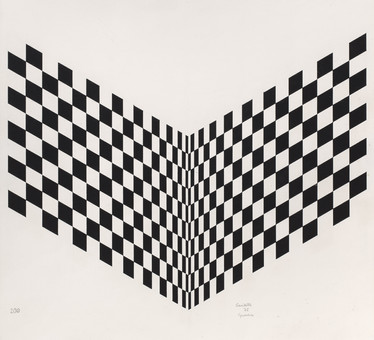Luiz Sacilotto

Santo André, Brazil, 1924 —
São Bernardo do Campo, Brazil, 2003
A member of Grupo Ruptura, Luiz Sacilotto devoted careful attention to the use of industrial materials, painstaking treatment of pigments, rigorous use of geometric shapes and technical accuracy to, following the precepts of Manifesto Ruptura, of which he was a signatory, to eliminate any trace of figuration from the work. , naturalism or expressionism.
Their Concretions are often built in alternations between positives and negatives that are established from the serialization of the modules, which ends up generating concrete digits, as if it were a controlled computational mathematics that can be repeated tirelessly to infinity, capable of explore and challenge the viewer’s visual and spatial perception. Thus, the Concreção 5629 (1956) relief vertically alternates uneven rows of dark triangles, whose relations form white triangles from the bottom, linking the visual predominance to the way the plane is observed. In Concreção 7553 (1975), the modules seem to obey a movement of expansion and retraction that forges visual volumes, triggering illusions of curve and depth, in a close proximity to op art. And in Concreção 8221 (1982), the perception of volume is created in the plane, as if the viewer were observing from above a structure in which the depth unfolds indefinitely.
Equally admirable are the sculptures by Sacilotto. In works such as Concreção 5816 (1958) and Concreção 5942 (1959), the artist works with aluminum and brass plates, building from the plane, through cuts and folds in the materials, three-dimensional shapes that alternate between full and empty, capturing the immateriality of absence and transforming it into an element as necessary to sculpture as matter. The same effect produces the large sculptures Concreção 0011 (2000) and Concreção 0005 (2000), both installed in Santo André, Sacilotto’s hometown, where Coronel Oliveira Lima street is paved with tiles that reproduce his works. Here, art is integrated into the heart of the industrial city, giving shape to modern life, realizing a fundamental ambition of concretism, which makes it entirely fair to echo the words of Waldemar Cordeiro when saying that Sacilotto is “the crossbeam of concrete art. ”
VRP